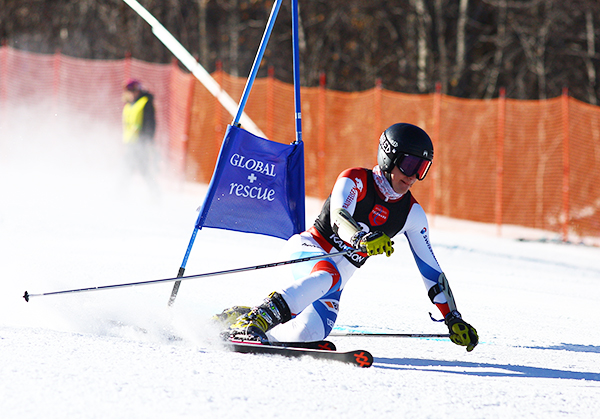After three FIS Telemark World Cup events were held at Suicide Six on January 20 to 22, the Telemark World Cup tour moved to Sugarbush for races on Wednesday, January 24, through Friday, January 26. The majority of the competitors, representing eight European countries, received their first taste of “eastern powder” when they arrived in Warren on Tuesday during a downpour of rain, soon followed by freezing temperatures Tuesday night. While Wednesday’s conditions were difficult in places with some clear frozen ice, after grooming on Wednesday night, the course conditions on Thursday and Friday could not have been better.
Telemark racing involves a combination of giant slalom (GS) race gates, a Nordic-style jump that requires a minimum distance be achieved, and cross-country skating … all within the same run, using the same equipment. The jump, located in the middle of a GS gate course, is about a meter in height with only a slight decrease in incline from the natural slope and no “kick.” It requires significant effort and Nordic jumping skills in order to clear the red line in the snow (typically 15 to 25 meters from the jump) and avoid the three-second penalty for failing to do so. The transition between the high-speed (commonly 40 to 50 mph) GS gates and the cross-country skating is facilitated by a 360-degree banked-turn snow feature with an unpronounceable Norwegian name that translates as “loop of rope."
ALPINE GS RACE SKIS
Competitors ski on alpine GS race skis mounted with telemark bindings and use long skating poles that look unwieldy in the gates but are essential for the skating. Currently, the FIS telemark discipline includes three different events: the Classic, a single-run event which involves the longest vertical drop, the highest gate count, the biggest jump, and the longest skate (sometimes causing competitors to collapse at the finish) in a two-plus-minute run; the Sprint Classic, which is an abbreviated version of the classic in a two-run combined time format of less than a minute; and the Parallel Sprint, still shorter than the Sprint Classic, a head-to-head dual event that involves a horse-gate style start (like the old U.S. pro slaloms) and separate gate courses that merge, skier-cross style, at high speed into the 360-degree banked turn, with competitors finishing the race skating together to the finish line like a Nordic race.
Sugarbush hosted all race events on the Spring Fling trail, with Classic events on Wednesday and Thursday and a Sprint Classic on Friday. While the original schedule called for a Classic, a Sprint, and a Parallel event, the low-elevation start required by the short Parallel event would require a jump location below Spring Road, where the flatness of the slope is less desirable for a jump landing. Based on the slope characteristics, combined with the fact that the World Cup had already had one of only three Classic events of the season canceled due to weather, the schedule was amended to run a second Classic event at Sugarbush in place of the Parallel.
For the women’s field, Wednesday’s Classic was won by Jasmin Taylor of Great Britain, with her second World Cup victory after a win at Suicide Six by the best competitive skier ever to come from Great Britain. She was followed by top World Cup contenders Argeline Tan Bouquet of France and Simone Oehrli of Switzerland. Connecticut College undergrad Sarah Carley was the top U.S. finisher in seventh place. For the men, Jure Ales of Slovenia skied to his second-ever World Cup victory after winning a Sprint at Suicide Six earlier in the week. Nicolas Michel, current WC Telemark points leader, was second and Stefan Matter of Switzerland was third. The highest U.S. finish was 12th place by Cory Snyder, originally from Littleton, NH, and currently attending Montana State University.
In Thursday’s Classic race, Argeline Tan Bouquet of France was the women’s winner, followed by World Cup points leader Johanna Holzmann of Germany and Jasmin Taylor of Great Britain. Sarah Carley again led the U.S. with a seventh-place finish. Phillippe Lau of France was the men’s winner, followed by Nicolas Michel and Bastien Dayer of Switzerland. Cory Snyder was the top American in 13th place.
In the Sprint Classic on Friday, Argeline Tan Bouquet and Phillippe Lau of France again stood atop the men’s and women’s podiums. After the race, Henri Borel, who has hosted numerous World Cup champions in his nearby bistro over the years, was pleased to celebrate with his camarades Francais after their wins, two days in a row, on the same ski trail that has been part of his own daily skiing routine for some decades. Switzerland’s Beatrice Zimmerman was second for the women, Johanna Holzmann of Germany was third, and Sarah Carley was eighth as top U.S. finisher. For the men, Nicholas Michel and Stefan Matter of Switzerland claimed the second and third spots, respectively. With the shorter course favoring the American men, Jeffrey Gay of Steamboat Springs, CO, broke the top 10 with a 10th-place finish.






